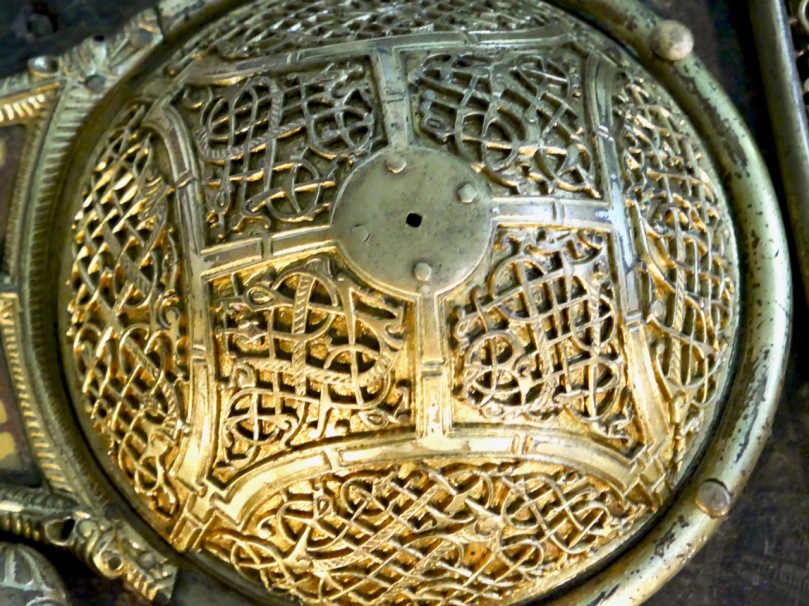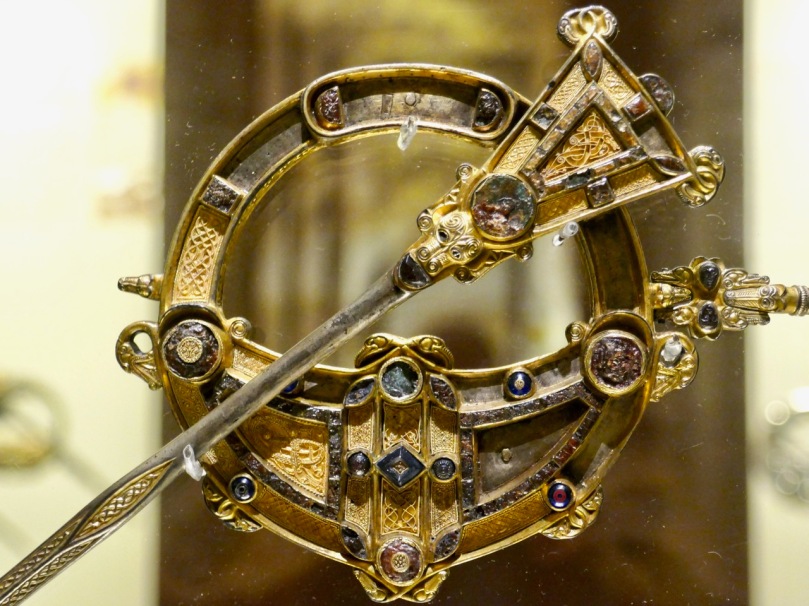The stained glass firm of J Watson & Co of Youghal not only represented a new type of Irish-based business when it started to operate in the 1880s but developed a uniquely Irish style of stained glass (see above). I introduced this topic in my post Symbols and Stories: Looking at Stained Glass, but I want to develop it properly in this post and provide further illustrations in the next. Watsons was first opened by Michael Buckley, who had Irish connections, as a branch of Cox, Sons, Buckley and Co of London but was eventually bought out by James Watson, a Yorkshire stained glass artisan who had come to work there a decade earlier. Members of the Watson family continued to make windows right up to 2012.*
This St Eltin window in Gougane Barra has been attributed to Michael Buckley. Note the Revivalist elements
Based in Youghal, the firm supplied stained glass all over Ireland, but especially in Munster. They competed with other new firms which had set up church supply and decorating businesses, mostly in Dublin. These included Joshua Clarke (father of Harry), James Pearse (father of Patrick and Willy) and the Earley Brothers, Thomas and John. All of them had learned the trade in Britain and some started as agents for such companies as Mayer of Munich and London or Hardman of Birmingham, but eventually employed their own artists and glaziers.
This is one of many Light of the World windows that Watsons produced, in St Brendan’s of Bantry Church of Ireland. Note the conventional Gothic canopies . This was a universal favourite, especially in Protestant churches and all the stained glass manufacturers had a version
This was a boom period for Irish church building and stained glass windows were, of course, one of the expressions of faith that could enliven and decorate the interiors. They also offered an opportunity for both clerical and lay people to contribute to the church and to commemorate deceased family members (and occasionally to commission an ego-stroking window for themselves).
Catherine O’Brien of An Túr Gloine painted this window for Kilcoe Church of the Most Holy Rosary in West Cork. Note the introduction of some interlacing as a minor element in the design. Patrick and Brigid, as the male and female patron saints of Ireland were always in demand for church windows
The choice of iconography for the window was dictated either by didactic imperatives (e.g. the Holy Family as a model to be emulated by the faithful) or by devotion to a particular saint, international, Biblical or local, or by church politics (e.g. Papal authority). This was also the period when the Celtic Revival was in full swing and artists of all kinds were busy crowding graveyards with Celtic crosses, stitching Book of Kells symbols onto vestments, and painting illuminated addresses with complicated knotwork. Buying from Irish firms, once they were able to supply the orders, quickly became preferred.
Harry Clarke did not incorporate much interlacing into his windows, but this one, of St Fachtna, in Castletownshend Church of Ireland, shows that he knew well how to do it
Nowadays the term Celtic is suspect: we no longer believe that the evidence exists for an Iron-Age invasion of a tall blonde race from the continent. Archaeologists and Art Historians often now use the term Medieval Insular Art, however Celtic Revival, as shorthand for the domination of a certain decorative style (as well as the re-discovery of a great literary tradition and the craze for antiquarianism) at the end of the nineteenth century and into the Irish Arts and Crafts period, is so well understood that I use the term, and ‘Revivalist’, here in that spirit.
Contrast the canopies in this window, with its intricate interlacing, with the conventional Gothic canopies of the Light of the World window above. Watson’s executed this one for Charleville Catholic Church
In her in-depth analysis of the Watson Archives, art historian Vera Ryan has demonstrated that orders for stained glass often stipulated that instead of the gothic canopies favoured by the English and German manufactures, windows should contain Celtic (or even ‘Keltic’) artwork. While other firms included some minor elements of interlacing in a design (see the Brigid and Fachtna windows above), no Irish stained glass firm delivered on this request better than Watsons of Youghal – it became one of their hallmarks and a real selling point for Irish clergy of both Catholic and Church of Ireland persuasions.
Models artists could learn from: Upper – a detail from St Manchan’s shrine, a replica of which was housed in the National Museum. Lower – The Christ Enthroned Page from the Book of Kells
This was the most popular style of art at the time for all kinds of objects and it’s not hard to understand why. First of all, the interlacing itself is delightful, quirky and complex and full of tiny surprises. Secondly, the Revivalist motifs were taken from a rich treasury of sacred and secular Medieval objects that formed the nucleus of the displays in the National Museum, which opened its doors in 1877. The Tara Brooch (below), for example, created a sensation when it was found it 1850 and became instantly iconic, with thousands of copies being made.
Thirdly, and perhaps most importantly, here was now a truly indigenous art of which we could be justly proud. In an era of evolving nationalism, images conjuring up a glorious Christian past, replete with our own saints, literature and high art, was a reminder of what we had once been and what we had lost as a nation.
The Shrine of St Patrick’s Bell – not only a beautiful object but a potent symbol of what was seen as a Golden Age in Ireland of learning and piety
While their figurative designs remained conventional – think bearded men in long robes or saintly women in nuns’ habits, all in the style of renaissance paintings – the artists at Watsons had fun developing increasingly elaborate frames and canopies to surround their figures. Added to this was a mastery of Irish lettering styles, deployed to great effect whether the text was in Irish, English or Latin.
The use of interlacing and an Irish lettering style. Two continuous ribbons link the upper and lower surrounds, with the corner interlacing twisting around them. The Irish script was still being taught to us in school in the 1950s and 60s
The net result was the development, in the hands of the expert and talented designers and painters at the Watson studio, of a hybrid style of stained glass window unique to Ireland – the overlayering of conventional objects of worship with the originally pre-Christian and later Early Christian/Early Medieval decorative style that came to be labelled ‘Celtic Revival’ at the end of the nineteenth century.
St Carthage, from his eponymous Catholic church in Lismore, Co Waterford. Details include the Book of Lismore, the Lismore Crozier (on display at the National Museum) and a whole galaxy of interlace motifs for the clothing and decorative surround
Next week – examples of Watsons’ use of Revivalist motifs and where to go to see them, as well as some original cartoons, now housed in the Crawford Gallery in Cork. I leave you with a detail from one of the windows employing interlace and lettering – but can you spot the signature?
*Much gratitude to Vera Ryan who has generously shared her Watson expertise with me, and to the Crawford Art Gallery for allowing access to the Watson Archive. I recommend Vera Ryan’s article Divine Light: A Century of Stained Glass in the Summer 2015 edition of the Irish Arts Review for those who would like to learn more about Watsons of Youghal.













Thanks Finola. Looking forward to Part 2, and …
LikeLiked by 1 person
Oh! Robert and Finola ……. totally stunning.
LikeLike
This was fascinating. Thank you so much.
LikeLiked by 1 person
The J. W. 3 in the bottom left hand corner
LikeLiked by 1 person
Wonderful colours and sinuous details – the interlacing is masterful and full of quirky and complex details.
LikeLike